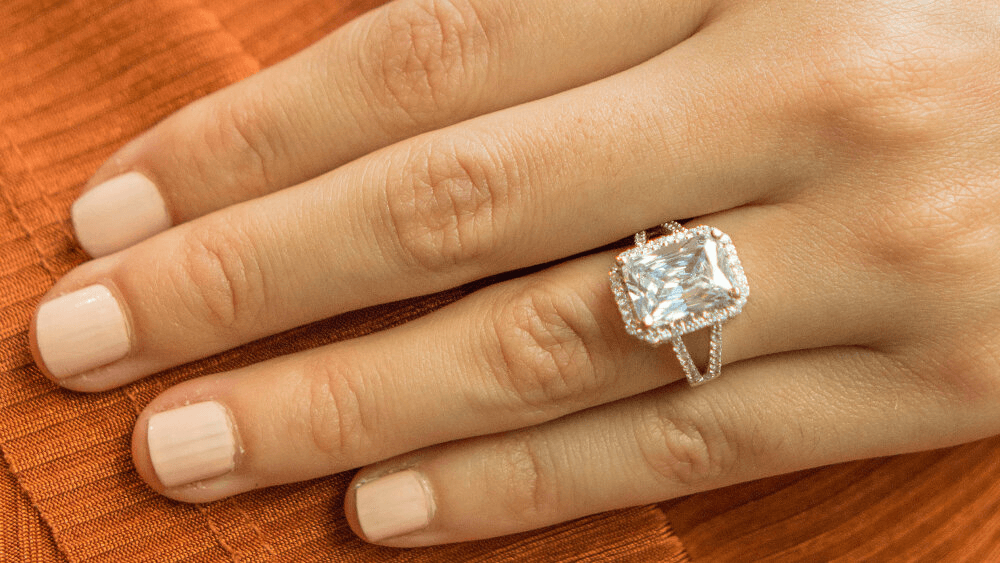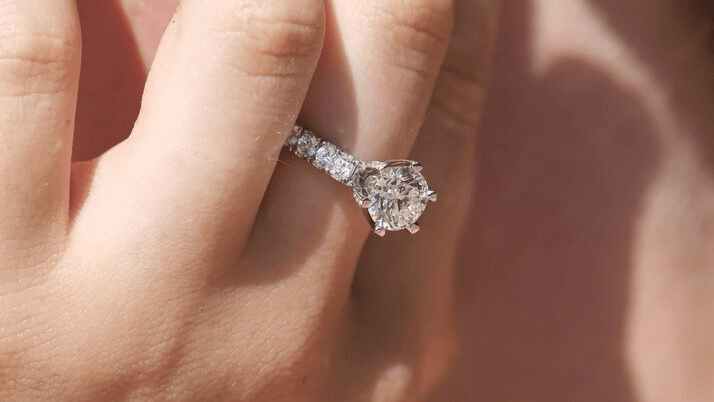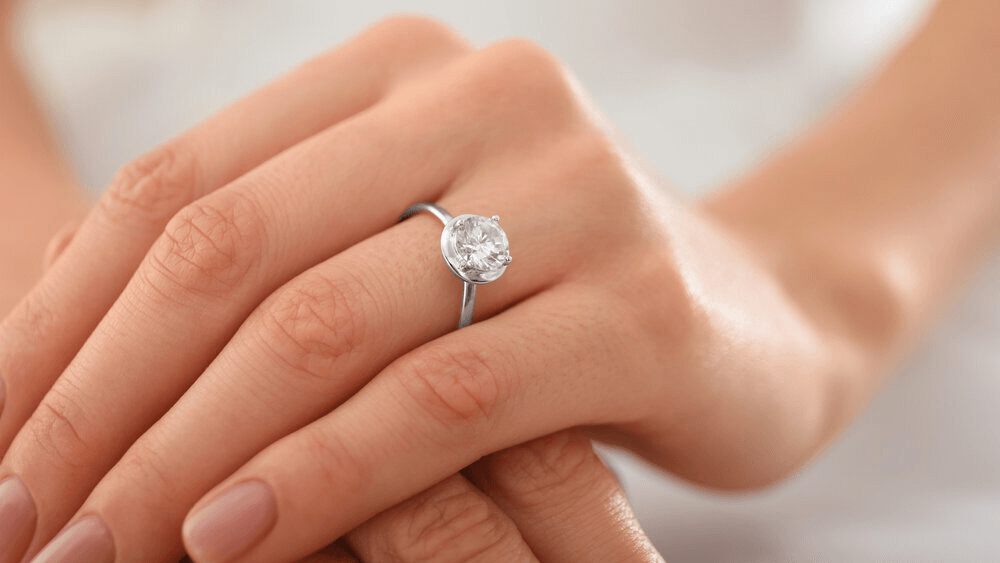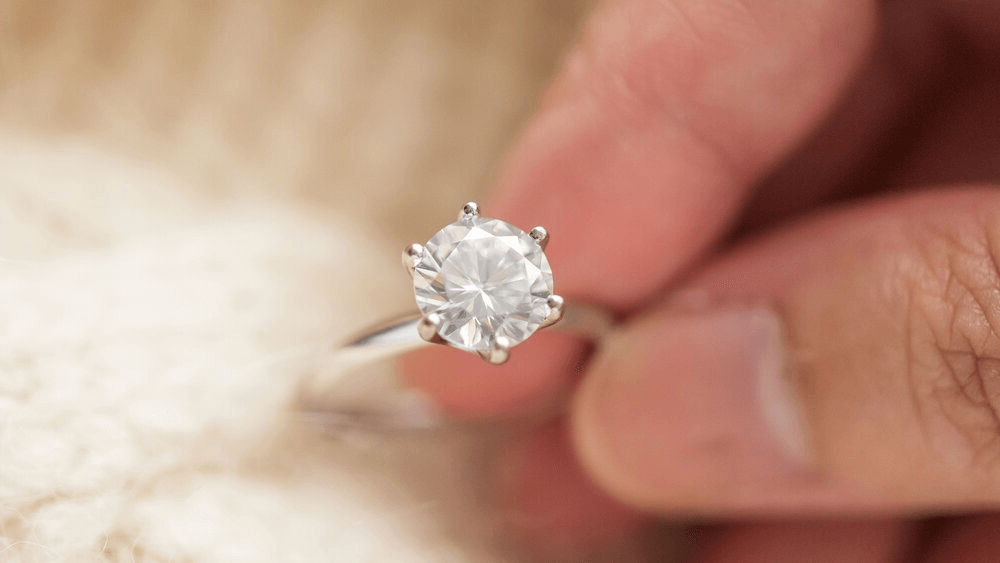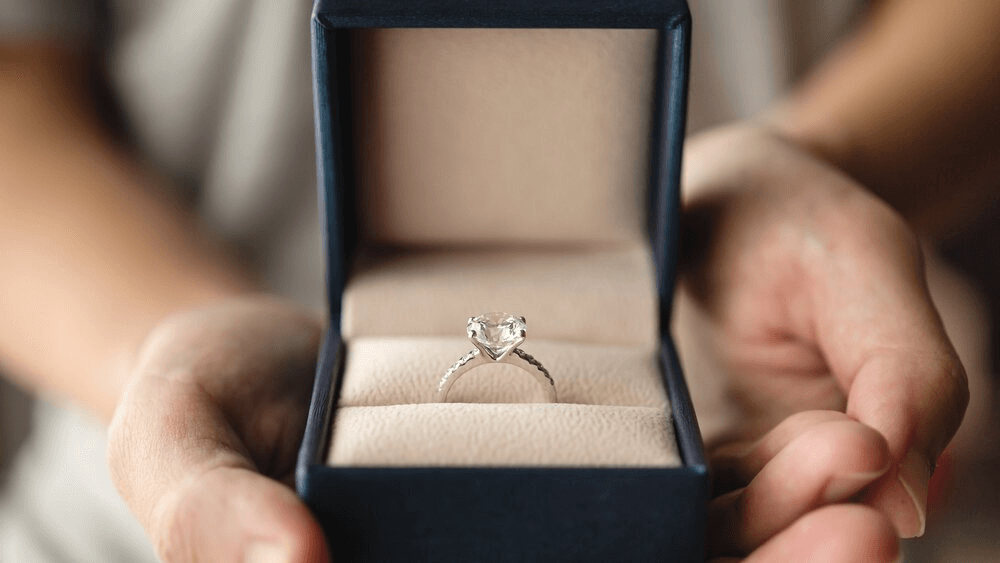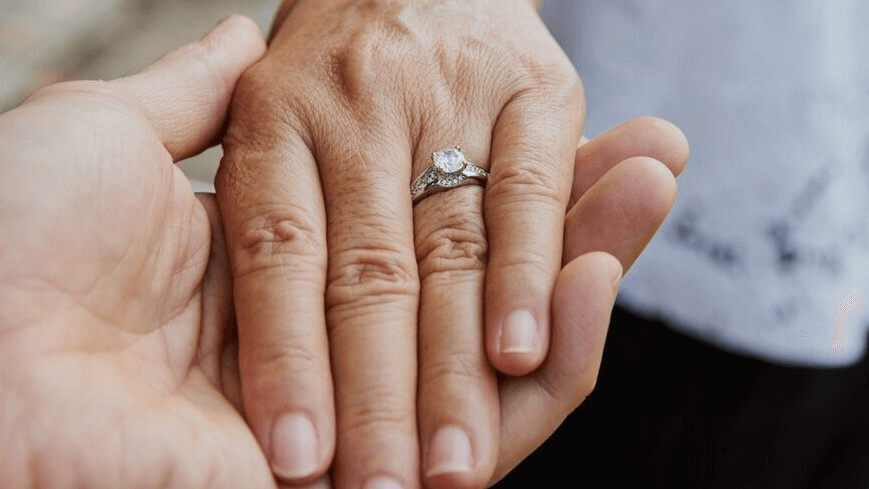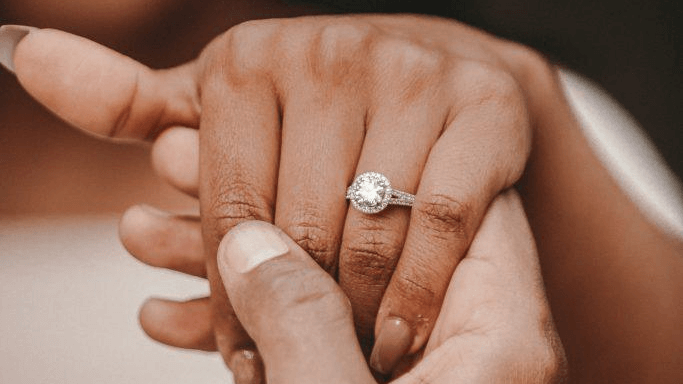$25,000 Engagement Ring Secrets: Discover the Luxury!

By Gary A.

Edited by Olivia H.
Published Aug 13, 2024
Edited on Feb 25, 2025
$25,000 is a great budget for an engagement ring. This article explains what you need to know to get the most out of that figure.
🎧 Listen to our expert insights:

Navigate this guide:
- 4 Quick Tips for Maximizing Your $25,000 Engagement Ring Budget
- Introduction to Luxury Rings
- Understanding the 4 C’s of Diamond Quality
- Styling the Perfect Ring
- The Investment Worth of $25,000 Rings
- Our Expert Take: The Journey to Your Perfect Ring
- 7 Frequently Asked Questions about $25,000 Engagement Rings
- Recently Purchased $25000 Engagement Rings for Inspiration
Before we dive deeper into the specifics, here are some practical tips to help guide your decision-making process:
4 Quick Tips for Maximizing Your $25,000 Engagement Ring Budget
Tip 1. Understand the 4 C’s:
- Carat: The weight of the diamond. With a $25,000 budget, you can expect a diamond with higher carat weight, but remember it’s just one factor of many.
- Clarity: Refers to any blemishes or inclusions in the diamond. Aim for a clarity grade of VS2 or better to ensure that any inclusions aren’t visible to the naked eye.
- Cut: A diamond’s cut determines its sparkle. An Excellent or Ideal cut can make a diamond look even more brilliant.
- Color: Diamonds are graded from D (colorless) to Z (light yellow). For the best value, consider a G or H grade, which will appear white but is less expensive than D or E grades.
Tip 2. Ring Setting:
- The setting can dramatically impact the ring’s appearance and price. Ensure it complements both the diamond and the wearer’s style. With a substantial budget, explore platinum or high-carat gold for durability and prestige.
Tip 3. Certification Matters:
- Always ask for a grading report from a reputable lab like the Gemological Institute of America (GIA) or the American Gem Society (AGS). This report ensures that the diamond’s attributes (like its 4 C’s) are accurately represented.
Tip 4. Avoid Lab-Grown As Natural is Preferred:
- With a $25,000 budget, you’ll come across both natural and lab-grown diamonds. Remember, while lab-grown diamonds may look similar, they typically don’t hold value like natural diamonds. If investment and resale value are considerations, lean towards natural diamonds.
Now that you’ve got these practical tips, use Jeweler AI below to find the perfect engagement ring that suits your style and budget:
Introduction to Luxury Rings
When it comes to engagement rings, the further you move up the price chart, the more quality you’re going to get. This might sound like an obvious point, but it’s worth noting because a lot of people might bypass a $25,000 engagement ring thinking it can’t be that much better than a $20,000 ring.
But you’d rarely find a $20,000 engagement ring dressed up as a $25,000 engagement ring. Assuming it’s authentic, there are reasons a $25,000 ring is valued at that price compared to a $20,000 ring, just as there are reasons a $20,000 ring is valued at that price compared to a $15,000 ring, and so on and so forth. Each time you step up the price chart, you’re stepping up the quality. In other words, you’re moving closer and closer to the pinnacle of luxury.
The Allure of a $25,000 Engagement Ring
If you’re pushing up your budget to $25,000, what you should be looking for compared to $20,000 are small but definite differences. These differences might show themselves in the cut of the diamond, the color, the clarity, or the carat weight. They might show themselves in a larger centre diamond, additional accent stones, superior metal quality or setting design.
All of these differences help to improve the quality of the ring itself, and therefore its allure. Even if a diamond shines just a tiny bit brighter, it makes a big impact, so these are the things you should be looking for to discern the price difference and understand how much more of a luxury this engagement ring is.
Understanding the 4 C’s of Diamond Quality
When it comes to looking for and understanding the 4 C’s, this will take a bit of research. Ordinarily, the 4 C’s will have been graded by the GIA, providing a comprehensive overview of the diamond’s quality and characteristics. We’ve written about this in depth before, but below is each ‘C’ and a brief description of what makes them important.
Carat Weight: More Than Just Size
Carat weight is not just about how big the diamond is. Overall, the carat will have a significant impact on the overall value, with larger carat weights being far rarer. It also impacts the design, the balance, and even the brilliance of the diamond – a larger diamond, when well-cut, will exhibit more fire and sparkle as a result. Follow this link to find out more: https://willyou.com/buying-guides/4cs/carat.
Clarity: The Key to a Flawless Sparkle
For the most part, the sparkle of the diamond will come down to the clarity. This refers to the presence or absence of internal or external imperfections – known as inclusions and blemishes.
Some of the grades, in this case, include ‘Flawless’, meaning there are no inclusions or blemishes visible under 10x magnification, ‘Very Very Slightly Included’, meaning the inclusions are difficult to see under 10x magnification, and ‘Included’, meaning the inclusions are obvious under 10x magnification. Click here to find out more.
Cut: Crafting the Perfect Reflection
We mentioned before that a larger diamond will exhibit more fire and sparkle if it’s well-cut, and that’s a key point to consider. How beautiful a diamond is nearly always depends on the cut, as this will impact everything from the brilliance, the light performance, the symmetry, and the overall appearance of the diamond itself. Here’s our full cut guide.
Color: Navigating the Spectrum of Brilliance
The last – but certainly not least – ‘C’ to think about is the color. This refers to the presence or absence of color in a diamond, with grades ranging from D (colorless) all the way to Z (light color). It should be noted that colorless diamonds are extremely rare, and it’s unlikely you’ll find one at $25,000.
Styling the Perfect Ring
Of course, other things you will need to think about are the type of diamond you go for – natural vs lab-grown – as well as the certification of the diamond itself – for authentication and security purposes. And once you’ve done that, you’ve also got to think of the metal type and style. We’re talking about an engagement ring, after all, not just a diamond – and that means taking into account how you pair the diamond with the perfect setting.

Ring Settings: Framing Your Diamond Right
In almost all cases, the setting of a diamond ring should be chosen to complement the diamond, not the other way around. Once you have decided on your diamond, then, you need to find something that emphasises it. The solitaire setting could be a great option here, as it allows maximum light to enter the stone, enhance the brilliance, and make it look larger than it already is.
If you’re looking for even more fire, the pave setting could be the one for you, as it features small diamonds set closely together around the band – adding more sparkle without detracting from the centre stone. Other settings to consider include the halo, prong setting, and vintage setting – all of which have a unique, timeless appeal that can perfectly emphasise the beauty of the diamond itself.
Metal Choices: The Foundation of Elegance
As mentioned before, the metal you go for will also make a big impact. This is a bit of a balancing act between design and practicality. For instance, while white gold might seem a little plain and obvious because it’s mixed with palladium – or nickel – it’s incredibly durable, which is just what you want when you’re going for a more expensive diamond.
Rose gold, on the other hand, is less durable, but certainly in fashion right now, with the color adding a unique, romantic appearance to the overall ring design. Platinum is a good choice too, being both beautiful and highly durable, but it’s typically more expensive than white, yellow, and rose gold, so you would need to double-check your budget before you invest.
Other options – that are not as common as platinum or gold – include palladium and titanium. Palladium, of course, is part of the platinum family, only it’s a lot more lightweight and cost-efficient, making it a good alternative if your budget turns out to be an issue. Titanium is also highly durable and often used in modern designs, which could make it perfect if you’re aiming for a more modernist approach with your setting. It should be said, however, that titanium is a very particular choice and doesn’t quite offer the same luxurious feel as gold or platinum, so you’ll have to think hard about what you want before you make that leap.
The Investment Worth of $25,000 Rings
Ensuring all of this – the setting and the four C’s – is about more than securing a great engagement ring for yourself. A ring costing $25,000 is an investment, with high-quality diamonds and metals often appreciating over time. There are other factors to think about here, of course.
For one thing, market trends will typically influence demand and supply, with rare colors – like pink and blue – often considered ‘investment grade’ diamonds that experience a high level of demand. The brand and craftsmanship will also come into play, and the maintenance of the ring – how often it’s been maintained and professionally cleaned – can indirectly support the value.
Resale Value: Understanding Market Dynamics
If you’re hoping to sell your ring somewhere down the line, we should mention how the market dynamics will impact resale value. Like cars, jewelry often depreciates immediately after purchase, and selling a ring on the secondary market typically fetches less than the original purchase price. If you’ve ensured the diamonds and metals are high quality, however, you’ll have a good chance of retaining a significant portion of the value – and as mentioned previously, it could be that the diamond has appreciated due to its quality and rarity.
Our Expert Take: The Journey to Your Perfect Ring
Earlier, we mentioned that choosing the right setting is about balancing aesthetics and durability, and in many ways, the same can be said for engagement ring shopping. Before you set off on your journey, it’s important to reflect on your – or your SO’s – individual style and weigh that alongside all the practical considerations. You want a ring that is undoubtedly you, but also a ring that could feasibly last for generations.
Many families, for instance, will pass down an engagement ring, ensuring the love and commitment that went into it never fizzles out. You want a ring that is beautiful enough to achieve that, while also being durable enough to withstand it. This requires a lot of careful planning, so take your time, think about what you want, what you need, and give the process the respect and attention that it deserves.
7 Frequently Asked Questions about $25,000 Engagement Rings
- Q1. What Can I Expect in a $25,000 Engagement Ring?
- Answer: With a budget of $25,000, you can expect a high-quality diamond with a good balance of carat, clarity, cut, and color. Rings in this price range often feature larger center stones, ranging from 1 to 2 carats or more, with excellent or ideal cuts for maximum brilliance, VS2 or higher clarity, and G or H color grades for a near-colorless appearance. Additionally, you can opt for luxurious settings in platinum or high-carat gold.
- Q2. Is a $25,000 Budget Enough for a High-Quality Engagement Ring?
- Answer: Absolutely. A $25,000 budget allows for a significant investment in a diamond engagement ring, ensuring both high-quality craftsmanship and exceptional diamond characteristics. You’ll have ample options for customization and the ability to select from the top tier of diamonds and settings.
- Q3. How Important Is the Certification for a Diamond Engagement Ring?
- Answer: Extremely important. A certification from a reputable lab, such as the GIA or AGS, verifies the diamond’s characteristics and ensures you’re getting a diamond that matches its description. It provides peace of mind and guarantees the quality and authenticity of your investment.
- Q4. Should I Consider Lab-Grown Diamonds for a $25,000 Engagement Ring?
- Answer: While lab-grown diamonds offer a cost-effective alternative to natural diamonds, for a $25,000 budget, most consumers prefer natural diamonds due to their lasting value and rarity. Lab-grown diamonds can be an option if size or ethical considerations are your priority, but natural diamonds typically hold their value better over time.
- Q5. Can I Get a Custom-Designed Engagement Ring for $25,000?
- Answer: Yes, a $25,000 budget is well-suited for custom-designed rings. This budget allows for a personalized engagement ring that reflects the wearer’s style, with the freedom to select every aspect, from the diamond to the setting and metal type, ensuring a truly unique piece.
- Q6. What Should I Prioritize When Choosing a $25,000 Engagement Ring?
- Answer: Focus on the cut quality and clarity of the diamond, as these significantly impact its brilliance and appearance. A well-cut diamond with high clarity will sparkle the most, making these factors more crucial than sheer carat size or color for the overall beauty of the ring.
- Q7. How Do I Ensure I’m Making a Smart Purchase?
- Answer: Research and compare options from reputable jewelers, insist on a detailed certification for the diamond, and consider working with a jeweler who offers a good return policy and warranty. Educating yourself on the 4 C’s and understanding your partner’s preferences will also guide you in making a decision that’s both smart and sentimental.
Find Your Dream Ring with Jeweler AI: A Tailored Experience Awaits!
Here are more specific budget topics to browse:
- Get the Diamond Glow: Stunning Engagement Rings Under $1000
- Unlocking Luxury for Less: Navigating Engagement Rings Under $2000
- $3,000 Engagement Rings: Dazzling Elegance on a Budget!
- $4000 Diamond Ring: A Smart Buyer’s Guide to Exceptional Value
- The Smart Shoppers Guide to a $5000 Diamond Engagement Ring
- Step-by-Step Guide: How to Find a Dazzling $6000 Engagement Ring
- $7K Diamond Rings: Maximize Your Brilliance and Value!
- Avoid the Pitfalls: How to Smartly Spend $10000 on an Engagement Ring
- Expert Tips On How To Find The Ideal $12000 Engagement Ring
- Unlocking the Mystique: What Can a $15,000 Engagement Ring Truly Offer?
- Unlocking the Secrets: What Does a $20,000 Engagement Ring Truly Offer?
- $30,000 Engagement Ring: Is It Worth the Luxe Price?
- $50K Engagement Rings: See Why They’re Worth Every Penny!
Recently Purchased $25000 Engagement Rings for Inspiration
Analyzing the table of recently purchased engagement rings can offer invaluable insights into the current trends and preferences among buyers at the $25,000 price point. Each entry highlights a unique blend of carat weight, diamond type, and setting style, showcasing the wide array of options available within this budget. For instance, many of the rings feature natural diamonds, which remain the favored choice for those prioritizing lasting value and investment potential. Notably, rings with carat weights around 2 to 3 carats dominate the listings, indicating a strong preference for substantial center stones that make a statement while still aligning with the overall quality expected at this price level. Additionally, the presence of both classic and contemporary settings, such as the vintage-inspired three-stone designs and the sleek custom bypass styles, reflects a diverse taste in aesthetics, appealing to different styles and personal stories. The data also reveals that while some buyers are exploring lab-grown options, the majority still lean towards natural diamonds, emphasizing the enduring allure and perceived prestige associated with them.
| Ring | Type | Price |
| 1.60 Carat D Color Natural Diamond Engagement Ring In Platinum | Natural | $23,186 |
| Custom 1.70 Carat Round Natural Diamond Bypass Engagement Ring | Natural | $23,539 |
| 2.5 Ct. Princess Cut Natural Diamond Ring With Side 2 Ct. Natural Diamonds | Natural | $23,557 |
| 2.5 Carat Natural Emerald Cut Engagement Ring (3 Stone Design) | Natural | $24,061 |
| VVS2 1.80 Carat G Color Natural Diamond Engagement Ring | Natural | $24,254 |
| 2 Carat Natural Diamond Antique Fairytale Inspired Engagement Ring | Natural | $24,341 |
| Three-Stone Pear Natural Diamond Vintage Engagement Ring (3 Carat) | Natural | $24,456 |
| Custom Emerald Half Bezel Natural Diamond Engagement Ring (3 Carat) | Natural | $24,585 |
| 5 Carat Lab Grown Diamond Ribbon Cushion Engagement Ring | Lab Grown | $24,883 |
| 2 Carat Round Custom U-Prong Natural Diamond Engagement Ring | Natural | $25,209 |
| 2.01 Carat Round Natural Diamond Taper Solitaire Engagement Ring in Yellow Gold | Natural | $25,437 |
| 14K Gold Natural Diamond Halo Ring With Double Claw-Prongs | Natural | $25,461 |
| 2 Carat Natural Diamond Round Halo Engagement Ring In Platinum | Natural | $26,523 |
| Custom 2.50 Carat Oval Natural Diamond Hidden Halo Engagement Ring | Natural | $26,990 |
| 3 Carat Cushion Cut Natural Diamond Ring In Yellow Gold | Natural | $27,009 |
| 10 Carat Lab Grown Pear Diamond Channel Set Engagement Ring | Lab Grown | $27,379 |
FOLLOW-UP GUIDE SERIES

